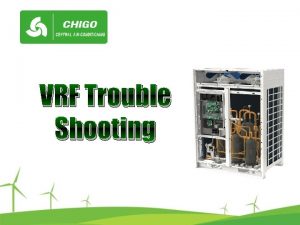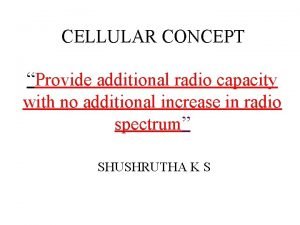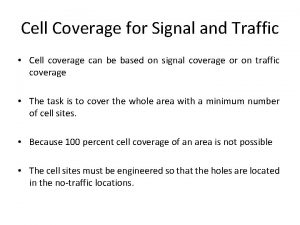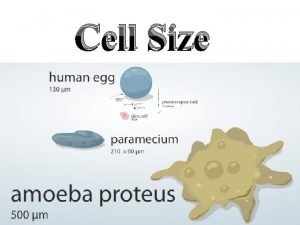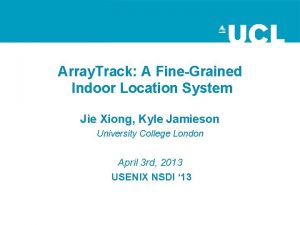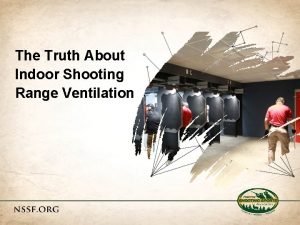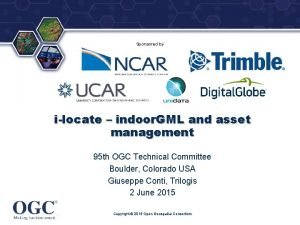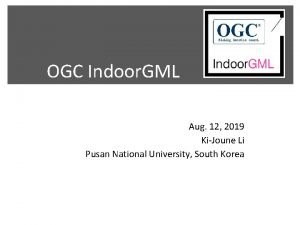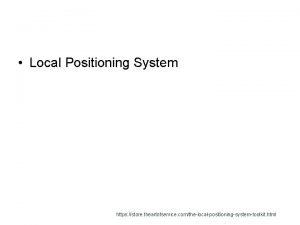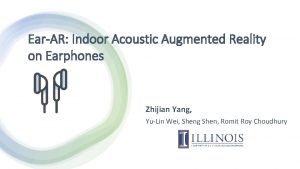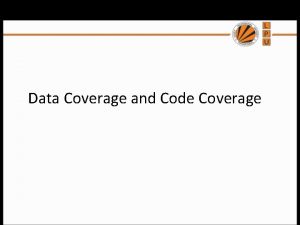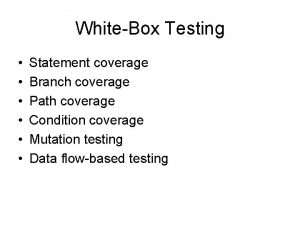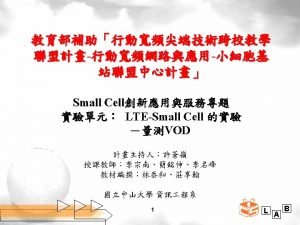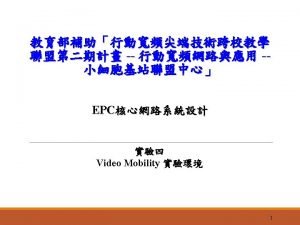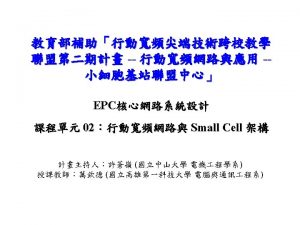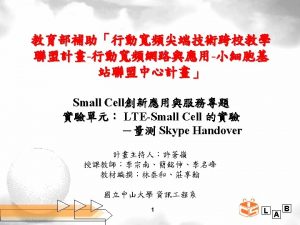Small Cell Capacity vs Coverage Indoor vs Outdoor




















- Slides: 20


Small Cell 的應用情境 Capacity vs. Coverage Indoor vs. Outdoor 50%-50% on Current Status Outdoor --- Extension of Macro Indoor --- Segregated Environment Distributed Antenna System (DAS) Operator vs. Users Deployed Use Cases Home Enterprise Urban Rural & Remote RRU Macro Cell Wi-Fi Residential Small Cell 1

Small Cell Deployment Status 全球Small Cell 佈建 不如預期發展 !! 技術上的問題 非技術的原因 3 G 時代 2000 ~ 2007: – 網路頻寬需求不高 2008 ~ 2010 – 開始考慮升級到 4 G 4 G: 2010 ~ now 全面性覆蓋優先 Source: Small Cell Forum, Feb. 2015 – 大基站建置優先 Small Cell Follows ? 2

Small Cell Market Trends Residential € Non-Residential Trend of unit price: home ↓ ; business or carrier-grade scenarios ↑ Growth Rate in 2013 : Residential : 7% ; Non-residential : 85% Revenue at 2015: Urban + Enterprise > Residential Revenue at 2018: Non-residential > 96% Source: Small Cell Forum, Feb. 2015 3

Small Cell 佈建的問題 Interference He. Net Major Issue in Small Cell Deployments Small cell Backhaul Wireless Backhaul mm. WAVE? 802. 11 ad ? RAN Integration Spectrum Management Handover Getting Worse as Small Cell coverage is getting smaller 4

Self Organizing Network (SON) SON Essential for Supporting Massive Small Cell Deployment Expensive for Network Deployment SON Functionality Self-Configuration Band Selection, Cell ID, Tx Power, Neighboring List, … Authentication and setup of secure tunnel to mobile core & OA&M Transport parameters (IP addresses, Qo. S negotiation, ; ) Self Optimization Neighbor list optimization Handover optimization Load balancing and capacity optimization Interference Mitigation/Management 5

EU METIS’s Vision on 5 G METIS 5 G Vision ITU-R 5 G Vision: IMT-2020 and Beyond Parameter Value for IMT 2020 User experienced data rate Peak data rate Mobility Latency Connection density 100 Mbit/s – 1 Gbit/s 20 Gbit/s 500 km/h 1 ms 106 #/Km 2 Energy efficiency 50 -100 times IMTAdvanced Spectrum efficiency 2/3/5 times IMTAdvanced Area Traffic Capacity 10 Mbps/m 2 Source: WP 5 D #21, Feb. 2015 6

1, 000 x Capacity Increase Challenges Spectrum Efficiency × Spectrum Extension/ Utilization × Network Efficiency/ Density 25 4 10 10 4 5 50 2. 5 4 100 = 1000 x Capacity High Challenge 7

METIS 5 G System Concepts Direct Device-to-Device (capacity, reliability, coverage, EE) Ultra-reliable Communication (Very low latency, multi-hop comm. ) Massive Machine Communications (Io. T, Very low cost & power) METIS 5 G System Concepts Ultra-dense Networks (very high data rates, crowds) Moving Networks (Coverage, V 2 V, In-vehicle apps) 8

UDN --- Technical Challenges Radio Access Technology LTE-A evolutionary based? or new revolutionary one ? New spectrum opportunities on mm. Wave with massive MIMO for link performance improvement Frame structure optimized for dynamic IP traffic Spectral efficiency increase New modulations, Enhanced link performance, Reduced control signalling overhead, Small cell Integration and Interaction Node clustering for collaboration Neighborhood discovery for dynamic clustering Resource / interference management, RAT selection, spectrum sharing Spectrum coordination to avoid in-band/out-of-band coexistence problems Reduction of the number of hand-over (HO) failure UDN/Macro integration Potential split of user and control plans 9

UDN --- Technical Challenges Wireless Backhauling Wireless backhaul will be a key enabler for indoor and outdoor UDN deployments 5 G UDN deployments will require less planning, optimization and management – when most of these functionalities will be automated and solved by the network itself – € € Less predictable needs for backhaul is available Wireless backhaul for UDN should be Self-configurable Adaptive to changes in network topology and network load 10

Qualcomm UDN Trial Deployment At NASCAR Phoenix Intl Raceway, April 2014 The densest LTE outdoor LTE network Avg. cell distance: 22 m (compared with traditional: 519 m) Deployed with unplanned manner Equivalent to 1, 000 Small Cells/km 2 40 x more capacity than traditional solution which is no interference management Data Source: Qualcomm 11

Simulation Result on UDN Simulation result 12

UDN Trial in ITRI Ultra‐Dense Network Hotspot: • Convenience Store • Fast Food Restaurant • Food Court • Post Office • Bank • 150 x 150 Square Meters • First Floor and Underground Floor • Peak Times: 3000 people • Off‐peak Times: 100 people Mobility: • Bi‐directional • Speed Limit: 30 Km/h • Max. 900 Meters Lane Outdoor: • Softball Field • Car Park • 125 x 150 Square Meters • Average 200 people Indoor: • Office • Meeting Room • Lecture Hall • Lobby • 100 x 35 Square Meters • 3 Stories High • Average 800 people Deploy with ITRI Small Cells; u. D Cell Deployment Plan: 100 Indoors/outdoors Small Cell (~ 1, 000 cells/km 2) Current Deployment: ~ 40 small Cells 13

ITRI LTE-A Small Cell Solution 64 Active Users Support UE CAT 6 Throughput : DL/UL 300 M/50 M 8/16 UE per TTI GPS/IEEE 1588 synchronization Sniffer Function X 2 & Scheduling支援e. ICIC Smart Antenna Supported RRM OAM SON D B Framewor k L 3 RRM SON Call Control Finite State Machine SON RRM RRC AS N. 1 ARM A 8/A 15 Protocol. RLC GTP-U S 1 A P Qo. S AS N. 1 X 2 A P SCTP UDCP Et. her ne. C t. P PD TI NDK . RRC. S 1 LSCHED Smart Antenna PDCP Framework • • 5 MHz Secondary CC PHY API MAC Cor e 1 UMAC 5 MHz Carrier Aggregation Primary CC RLC LMAC Sm art ante nna USCHE D TX Cor e 0 Cor e 2 RF Chip/ RF Mod ule 14 B aseband PHY AD AD C CC DA DA C C CC C FP GA RX Cor SRIO e 3 Tx/Rx Filtering and Access RF Contro l Timing Control 14

Centralized SON Server SON Algorithm ITRI SON Server (He. MS + SON Agent) MME/S-GW CWMP FTP TCP IP IP L 1/L 2 ITRI Small Cell Backhaul Network RRM SON OAM PM He. NB Controller SQLite ITRI Small Cell UE RRC GTPU PDCP UDP RLC S 1 AP X 2 AP SCTP CWM P FTP TCP IP MAC ITRI Small Cell L 1/L 2 PHY CWMP/FTP UE X 2 CWMP (TR‐ 069) (SON Server調整Small Cell系統參數) FTP (上傳Performance Report) S 1 15

Interference Management ‐ 50% ICIC Coordination ‐ 26% ‐ 30% ICIC、e. ICIC機制在UDN環境效能下降 ‐ 30% Mean BS Throughput Inter‐site distance in meters e. ICIC Coordination 16

LTE-A Dual RAT Smart Antenna SON/RRM + Smart Antenna RRM Beam Control SON 17

Dual RAT: LTE-A/Wi. Fi Aggregation IP Packet RRCRRC USched PDCP/RLC LTE Wi-Fi CN App Internet LTE. L 2 PDCP/RLC Multi‐‐Radio orotn Radiono rtlo. C Multi‐Radio Control UMAC LTELTE driver Wi. Fidriverdriver Wi. Fi radio LTE radio MRCMRC Mechanism Mechansm i. M echansm i LTE. L 2 UE 1 (w/ MRC) Wi. Fidriver Wi. Fi radio UE 2 (w/ MRC) 18

ITRI 5 G Project: mm. WAVE based Small cell 1 Gb. E Application 1 Gb. E CPU/GPU L 2/L 3 Server 1 Gb. E/ 10 Gb. E Switch 1 Gb. E DSP Subframe Enc/Dec ADI IF SRIO 1 Gb. E DSP Subframe SRIO Enc/Dec 1 Gb. E DSP Subframe Enc/Dec SRIO BBU IF ADI IF CPRI Decoder DSP Tx/Rx Sync RF Transceiver ADI IF RF T/R Module RF Control AC/DC Power RRH mm. Wave Prototype Demonstration in Globalcomm 2014: ~1 G bps 19
 Indoor and outdoor sports activities
Indoor and outdoor sports activities Types of games outdoor
Types of games outdoor Indoor and outdoor advertising media
Indoor and outdoor advertising media Indoor outdoor communication error
Indoor outdoor communication error Radio capacity may be increased in cellular concept by *
Radio capacity may be increased in cellular concept by * Cell coverage for signal and traffic
Cell coverage for signal and traffic Production units have an optimal rate of output where:
Production units have an optimal rate of output where: Small cell size
Small cell size Trbonet indoor
Trbonet indoor Batco batting cages
Batco batting cages Supplements for field hockey
Supplements for field hockey Specialty cottage indoor
Specialty cottage indoor Arraytrack: a fine-grained indoor location system
Arraytrack: a fine-grained indoor location system Shooting range ventilation
Shooting range ventilation Indoor easter holidays
Indoor easter holidays Indoor gml
Indoor gml Indoor gml
Indoor gml Indoor air pollution examples
Indoor air pollution examples Neuromarketing indoor-gps
Neuromarketing indoor-gps Indoor cranes safe lifting operations
Indoor cranes safe lifting operations Ear-ar: indoor acoustic augmented reality on earphones
Ear-ar: indoor acoustic augmented reality on earphones



